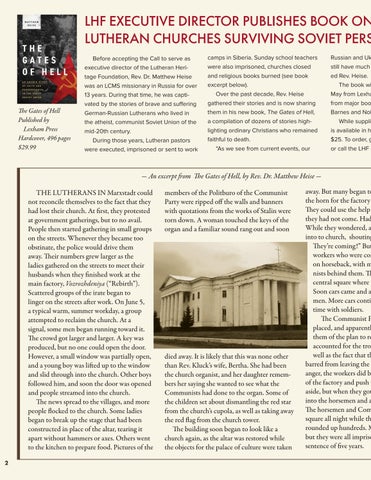LHF EXECUTIVE DIRECTOR PUBLISHES BOOK ON LUTHERAN CHURCHES SURVIVING SOVIET PERS
The Gates of Hell Published by Lexham Press Hardcover, 496 pages $29.99
Before accepting the Call to serve as executive director of the Lutheran Heritage Foundation, Rev. Dr. Matthew Heise was an LCMS missionary in Russia for over 13 years. During that time, he was captivated by the stories of brave and suffering German-Russian Lutherans who lived in the atheist, communist Soviet Union of the mid-20th century. During those years, Lutheran pastors were executed, imprisoned or sent to work
camps in Siberia. Sunday school teachers were also imprisoned, churches closed and religious books burned (see book excerpt below). Over the past decade, Rev. Heise gathered their stories and is now sharing them in his new book, The Gates of Hell, a compilation of dozens of stories highlighting ordinary Christians who remained faithful to death. “As we see from current events, our
Russian and Uk still have much ed Rev. Heise. The book wi May from Lexha from major boo Barnes and Nob While suppli is available in h $25. To order, g or call the LHF o
- An excerpt from The Gates of Hell, by Rev. Dr. Matthew Heise THE LUTHERANS IN Marxstadt could not reconcile themselves to the fact that they had lost their church. At first, they protested at government gatherings, but to no avail. People then started gathering in small groups on the streets. Whenever they became too obstinate, the police would drive them away. Their numbers grew larger as the ladies gathered on the streets to meet their husbands when they finished work at the main factory, Vozrozhdeniya (“Rebirth”). Scattered groups of the irate began to linger on the streets after work. On June 5, a typical warm, summer workday, a group attempted to reclaim the church. At a signal, some men began running toward it. The crowd got larger and larger. A key was produced, but no one could open the door. However, a small window was partially open, and a young boy was lifted up to the window and slid through into the church. Other boys followed him, and soon the door was opened and people streamed into the church. The news spread to the villages, and more people flocked to the church. Some ladies began to break up the stage that had been constructed in place of the altar, tearing it apart without hammers or axes. Others went to the kitchen to prepare food. Pictures of the 2
members of the Politburo of the Communist Party were ripped off the walls and banners with quotations from the works of Stalin were torn down. A woman touched the keys of the organ and a familiar sound rang out and soon
died away. It is likely that this was none other than Rev. Kluck’s wife, Bertha. She had been the church organist, and her daughter remembers her saying she wanted to see what the Communists had done to the organ. Some of the children set about dismantling the red star from the church’s cupola, as well as taking away the red flag from the church tower. The building soon began to look like a church again, as the altar was restored while the objects for the palace of culture were taken
away. But many began to the horn for the factory They could use the help they had not come. Had While they wondered, a into to church, shouting They’re coming!” But workers who were com on horseback, with m nists behind them. Th central square where t Soon cars came and a men. More cars conti time with soldiers. The Communist P placed, and apparentl them of the plan to re accounted for the tro well as the fact that th barred from leaving the p anger, the workers did b of the factory and push t aside, but when they got into the horsemen and a The horsemen and Com square all night while th rounded up hundreds. M but they were all impriso sentence of five years.



